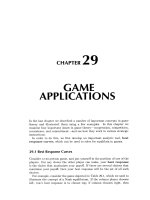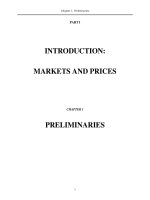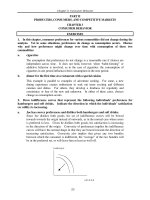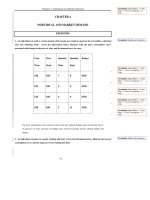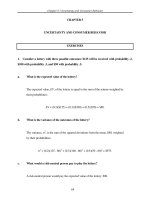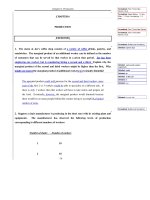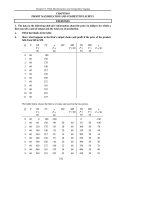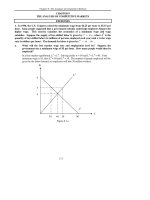Tài liệu Bài tập về Kinh tế vĩ mô bằng tiếng Anh - Chương 7 ppt
Bạn đang xem bản rút gọn của tài liệu. Xem và tải ngay bản đầy đủ của tài liệu tại đây (114.19 KB, 11 trang )
Chapter 7: The Costs of Production
84
CHAPTER 7
THE COST OF PRODUCTION
EXERCISES
1. Joe quits his computer-programming job, where he was earning a salary of $50,000 per
year to start his own computer software business in a building that he owns and was
previously renting out for $24,000 per year. In his first year of business he has the
following expenses: salary paid to himself $40,000, rent, $0, and other expenses $25,000.
Find the accounting cost and the economic cost associated with Joe’s computer software
business.
The accounting cost represents the actual expenses, which are $40,000+$0 +
$25,000=$65,000. The economic cost includes accounting cost, but also takes
into account opportunity cost. Therefore, economic will include, in addition to
accounting cost, an extra $24,000 because Joe gave up $24,000 by not renting the
building , and an extra $10,000 because he paid himself a salary $10,000 below
market ($50,000-$40,000). Economic cost is then $99,000.
2. a. Fill in the blanks in the following table.
Units of
Output
Fixed
Cost
Variable
Cost
Total
Cost
Marginal
Cost
Average
Fixed
Cost
Average
Variable
Cost
Average
Total Cost
0 100 0 100 -- -- 0 --
1 100 25 125 25 100 25 125
2 100 45 145 20 50 22.5 72.5
3 100 57 157 12 33.3 19 52.3
4 100 77 177 20 25 19.25 44.25
5 100 102 202 25 20 20.4 40.4
6 100 136 236 34 16.67 22.67 39.3
7 100 170 270 34 14.3 24.3 38.6
8 100 226 326 56 12.5 28.25 40.75
9 100 298 398 72 11.1 33.1 44.2
10 100 390 490 92 10 39 49
b. Draw a graph that shows marginal cost, average variable cost, and average total
cost, with cost on the vertical axis and quantity on the horizontal axis.
Average total cost is u-shaped and reaches a minimum at an output of 7, based on
the above table. Average variable cost is u-shaped also and reaches a minimum at
an output of 3. Notice from the table that average variable cost is always below
average total cost. The difference between the two costs is the average fixed cost.
Marginal cost is first diminishing, to a quantity of 3 based on the table, and then
increases as q increases. Marginal cost should intersect average variable cost and
average total cost at their respective minimum points, though this is not accurately
reflected in the numbers in the table. If the specific functions had been given in
the problem instead of just a series of numbers, then it would be possible to find
the exact point of intersection between marginal and average total cost and
Chapter 7: The Costs of Production
marginal and average variable cost. The curves are likely to intersect at a
quantity that is not a whole number, and hence are not listed in the above table.
3. A firm has a fixed production cost of $5,000 and a constant marginal cost of production
of $500 per unit produced.
a. What is the firm’s total cost function? Average cost?
The variable cost of producing an additional unit, marginal cost, is constant at $500,
so , and
AVC
VC = $500q
=
VC
q
=
$500q
q
= $500.
Fixed cost is $5,000 and
average fixed cost is
$5,000
q
. The total cost function is fixed cost plus variable
cost or TC=$5,000+$500q. Average total cost is the sum of average variable cost
and average fixed cost:
ATC = $500 +
$5,000
q
.
b. If the firm wanted to minimize the average total cost, would it choose to be very
large or very small? Explain.
The firm should choose a very large output because average total cost will continue
to decrease as q is increased. As q becomes infinitely large, ATC will equal $500.
4. Suppose a firm must pay an annual tax, which is a fixed sum, independent of whether it
produces any output.
a. How does this tax affect the firm’s fixed, marginal, and average costs?
Total cost, TC, is equal to fixed cost, FC, plus variable cost, VC. Fixed costs do
not vary with the quantity of output. Because the franchise fee, FF, is a fixed
sum, the firm’s fixed costs increase by this fee. Thus, average cost, equal to
FC +VC
q
, and average fixed cost, equal to
FC
q
, increase by the average franchise
fee
FF
q
. Note that the franchise fee does not affect average variable cost. Also,
because marginal cost is the change in total cost with the production of an
additional unit and because the fee is constant, marginal cost is unchanged.
b. Now suppose the firm is charged a tax that is proportional to the number of items it
produces. Again, how does this tax affect the firm’s fixed, marginal, and average
costs?
Let t equal the per unit tax. When a tax is imposed on each unit produced, variable
costs increase by tq. Average variable costs increase by t, and because fixed costs
are constant, average (total) costs also increase by t. Further, because total cost
increases by t with each additional unit, marginal costs increase by t.
5. A recent issue of Business Week reported the following:
During the recent auto sales slump, GM, Ford, and Chrysler decided
it was cheaper to sell cars to rental companies at a loss than to lay off
workers. That’s because closing and reopening plants is expensive,
85
Chapter 7: The Costs of Production
86
partly because the auto makers’ current union contracts obligate
them to pay many workers even if they’re not working.
When the article discusses selling cars “at a loss,” is it referring to accounting profit or
economic profit? How will the two differ in this case? Explain briefly.
When the article refers to the car companies selling at a loss, it is referring to
accounting profit. The article is stating that the price obtained for the sale of the
cars to the rental companies was less than their
accounting cost. Economic profit
would be measured by the difference of the price with the opportunity cost of the
cars. This opportunity cost represents the market value of all the inputs used by
the companies to produce the cars. The article mentions that the car companies
must pay workers even if they are not working (and thus producing cars). This
implies that the wages paid to these workers are sunk and are thus not part of the
opportunity cost of production. On the other hand, the wages would still be
included in the accounting costs. These accounting costs would then be higher
than the opportunity costs and would make the accounting profit lower than the
economic profit.
6. Suppose the economy takes a downturn, and that labor costs fall by 50 percent and are
expected to stay at that level for a long time. Show graphically how this change in the
relative price of labor and capital affects the firm’s expansion path.
Figure 7.6 shows a family of isoquants and two isocost curves. Units of capital are
on the vertical axis and units of labor are on the horizontal axis. (Note: In drawing
this figure we have assumed that the production function underlying the isoquants
exhibits constant returns to scale, resulting in linear expansion paths. However, the
results do not depend on this assumption.)
If the price of labor decreases while the price of capital is constant, the isocost
curve pivots outward around its intersection with the capital axis. Because the
expansion path is the set of points where the MRTS is equal to the ratio of prices, as
the isocost curves pivot outward, the expansion path pivots toward the labor axis.
As the price of labor falls relative to capital, the firm uses more labor as output
increases.
Chapter 7: The Costs of Production
Capital
Labor
2
1
3
4
1234
5
Expansion path
before wage fall
Expansion path
after wage fall
Figure 7.6
7. The cost of flying a passenger plane from point A to point B is $50,000. The airline flies
this route four times per day at 7am, 10am, 1pm, and 4pm. The first and last flights are
filled to capacity with 240 people. The second and third flights are only half full. Find the
average cost per passenger for each flight. Suppose the airline hires you as a marketing
consultant and wants to know which type of customer it should try to attract, the off-peak
customer (the middle two flights) or the rush-hour customer (the first and last flights).
What advice would you offer?
The average cost per passenger is $50,000/240 for the full flights and $50,000/120
for the half full flights. The airline should focus on attracting more off-peak
customers in order to reduce the average cost per passenger on those flights. The
average cost per passenger is already minimized for the two peak time flights.
8. You manage a plant that mass produces engines by teams of workers using assembly
machines. The technology is summarized by the production function.
q = 5 KL
where q is the number of engines per week, K is the number of assembly machines, and L is
the number of labor teams. Each assembly machine rents for r = $10,000 per week and
each team costs w = $5,000 per week. Engine costs are given by the cost of labor teams and
machines, plus $2,000 per engine for raw materials. Your plant has a fixed installation of 5
assembly machines as part of its design.
a. What is the cost function for your plant — namely, how much would it cost to
produce q engines? What are average and marginal costs for producing q engines?
How do average costs vary with output?
K is fixed at 5. The short-run production function then becomes q = 25L. This
implies that for any level of output q, the number of labor teams hired will be
L =
q
25
. The total cost function is thus given by the sum of the costs of capital,
labor, and raw materials:
87
Chapter 7: The Costs of Production
TC(q) = rK +wL +2000q = (10,000)(5) + (5,000)(
q
25
) + 2,000 q
TC(q) = 50,000 +2200q.
The average cost function is then given by:
AC
(
q
)
=
T
C
(
q
)
q
=
50,000
+
2200
q
q
.
and the marginal cost function is given by:
MC
(
q
)
=
∂TC
∂q
=
2200.
Marginal costs are constant and average costs will decrease as quantity increases
(due to the fixed cost of capital).
b. How many teams are required to produce 250 engines? What is the average cost
per engine?
To produce q = 250 engines we need labor teams
L =
q
25
or L=10. Average costs
are given by
AC
(
q =
250)
=
50,000
+
2200(250)
250
=
2400.
c. You are asked to make recommendations for the design of a new production facility.
What capital/labor (K/L) ratio should the new plant accommodate if it wants to
minimize the total cost of producing any level of output q?
We no longer assume that K is fixed at 5. We need to find the combination of K
and L that minimizes costs at any level of output q. The cost-minimization rule is
given by
MP
r
=
MP
w
.
KL
To find the marginal product of capital, observe that increasing K by 1 unit
increases q by 5L, so MP
K
= 5L. Similarly, observe that increasing L by 1 unit
increases Q by 5K, so MP
L
= 5K. Mathematically,
MP
K
=
∂Q
∂K
=
5
L
and
MP
L
=
∂Q
∂L
=
5
K
.
Using these formulas in the cost-minimization rule, we obtain:
5L
r
=
5
K
w
⇒
K
L
=
w
r
=
5000
10,000
=
1
2
.
The new plant should accommodate a capital to labor ratio of 1 to 2. Note that the
current firm is presently operating at this capital-labor ratio.
9. The short-run cost function of a company is given by the equation TC=200+55q, where
TC is the total cost and q is the total quantity of output, both measured in thousands.
a. What is the company’s fixed cost?
88
When q = 0, TC = 200, so fixed cost is equal to 200 (or $200,000).
